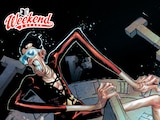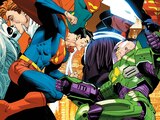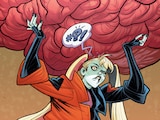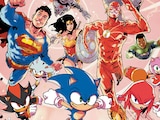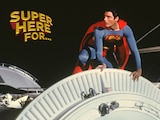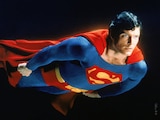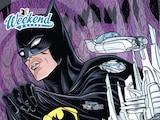Hello, I’m Alex Jaffe, your intrepid investigator for our monthly feature ASK…THE QUESTION. If you’re a member of the DC Community (and if not, why aren’t you?), you may already be familiar with my work under the sobriquet of HubCityQuestion. It’s my regular endeavor to answer whatever questions you may have about the breadth, history and minutiae of the DC Universe, no matter how granular or obscure. If you’d like to submit a question of your own, you can stop by my office at any time to make your inquiries, each of which I will in time address to the best of my ability. Let’s get some answers!
Studying the Ultra-Humanites

Reaganfan78 and Numbuh1Nerd ask:
Does the DC UNIVERSE INFINITE library have the comic where Ultra-Humanite first became a gorilla? And speaking of Ultra-Humanite, how many different bodies has he used?
The Ultra-Humanite is often credited as the original super-villain, having first vexed the Man of Steel in 1939’s Action Comics #13. It’s there that we see him in his original form, as a bald mad scientist. By Action Comics #20-21, Ultra-Humanite, whose real name we wouldn’t learn until decades later, had performed his most famous feat for the first time: transferring his brain into an entirely new body. In this case, it was actress Dolores Winters, his second-most infamous transformation.

Ultra-Humanite doesn’t appear again until 1980’s Superman Family #201, where Ultra-Humanite attempts—and fails—to pull another switch into the body of Bruce Wayne. 1981’s Justice League of America #195-197 (indeed available on DC UNIVERSE INFINITE) is where Ultra-Humanite assumes his most iconic albino ape form, as founder of the new Secret Society of Super-Villains.
(Interestingly, Ultra-Humanite wasn’t even the first DC super-villain to transfer his brain into an albino gorilla. That would be Xavier Simon, who battled Batman in 1979’s Detective Comics #482.)

The “Mr. and Mrs. Superman” feature, which ran in Bronze Age issues of Action Comics and Superman Family, revealed a different fate for Ultra-Humanite. Here, in an alternate timeline where Superman and Lois Lane had gotten married, Ultra-Humanite had transferred his brain from Dolores Winters to a giant winged ant, so as to manipulate Lana Lang in her capacity as the Insect Queen.
Ultra-Humanite’s next transformation is a 1942 flashback in 1988’s Young All-Stars #12, when we learn that the original attempted transfer to his gorilla form initially went wrong, putting him in the body of a Tyrannosaurus Rex.

In 1991’s Justice Society of America #3, Ultra-Humanite appears in a more humanoid body with some ape-like features, most notable for its red unitard and cape with yellow “U” belt buckle.
In the semi-canon Golden Age limited series, we discover that Ultra-Humanite transferred his mind after World War II into the body of Tex Thompson, the Americommando, who uses the hero’s prestige in a bid for the post-war presidency.
1997’s Legends of the DC Universe #1-3 is a retelling of Ultra-Humanite’s origins as scientist Morgan Wilde, who invents the technology of mind-transference and uses it to seek revenge on Lex Luthor for his wife’s murder. Wilde attempts to destroy LexCorp from the inside first in the body of employee Edward Carlyle, and then as Drake, Luthor’s chief of security, before escaping.

That brings us to another alternate continuity, the 1999 Superman/Batman: Generations series which posits a Superman and Batman who age in real time from their debuts in the 1930s. At the climax of the series’ first volume, it’s revealed that Lex Luthor had in fact been Ultra-Humanite nearly this entire time, having formerly been Luthor’s lackey before taking his body for himself.
Ultra-Humanite returns to modern continuity in 2000’s JSA Annual #1, where he appears in a bald, black-bearded apelike body, in a purple leotard covered in spikes. It’s pretty close to his classic ape appearance, but different enough that I’d count it as separate.
This form appears only briefly, however, setting the stage for Ultra-Humanite’s most successful gambit yet: gaining control of the all-powerful Thunderbolt by taking the body of Johnny Thunder, in 2002’s JSA #32.

Ultra-Humanite is reintroduced as “Gerard Shugel” in the 2009 Power Girl series, eventually taking the body of Power Girl’s young geokinetic sidekick Atlee in Power Girl #10. Shugel is restored to a clone of his original body, his mind erased of his time as Ultra-Humanite, and retires from villainy as a reformed employee of Power Girl’s Starrware.
In the Young Justice animated series tie-in comics, we see that Ultra-Humanite was transferred into the iconic gorilla body from an unnamed old woman. I’m not counting that as a separate body, though, since I’m fairly certain that was intended to be Dolores Winters.
After the New 52, Ultra-Humanite was reinvented as a monstrous alien creature in 2014’s Action Comics #37-39 as a powerfully telepathic prisoner of the Phantom Zone, a horrible amalgam of beasts with a writhing mass of tentacles and an apelike skull.

The classic Ultra-Humanite is reintroduced in 2015’s Earth 2: Society, staying in his gorilla form but employing a squadron of “Humanites” for his bidding. Like his New 52 counterpart, this Ultra-Humanite is able to control other people’s minds, like Alan Scott’s in Earth 2: Society #16, but it’s not quite the same thing as taking the body as his own, so I’m choosing not to count it.
By 2016’s Rebirth, the original Ultra-Humanite had been fully re-integrated back into mainstream continuity. Like the last two incarnations, this version of Ultra-Humanite has the power to control other minds without abandoning his own.
That changes in 2021’s Superman and the Authority #3, when Ultra-Humanite prepares for a final battle with Superman by implanting his mind into the body of Solomon Grundy. But as of October’s Superman: Son of Kal-El #16, he’s back in gorilla mode.

Finally, there’s the transformation which I suspect prompted these questions in Season 3 of Stargirl… I won’t reveal its nature for those who haven’t seen it yet, but it adds one more to the tally.
So, across all media and continuities, our number of Ultra-Humanite bodies so far is sixteen. But there’s always room for more!
Evergreen Family Tree

bookwormfitzpatrick.91230 asks:
Does John Stewart have any siblings? I distinctly remember him having a nephew in JLU but all my leads to find info on his family have come up cold.
I believe you’re misremembering, Bookworm. You may be thinking of the Justice League episode “Only a Dream,” where John interacts with a kid from his neighborhood in his dreamstate, but they aren’t related.
However, that isn’t to say he doesn’t have siblings elsewhere. In 2002’s Green Lantern #147, we get to know a little about John Stewart’s siblings as he works through some repressed trauma with his therapist. He has a younger brother, Damon, and a younger sister, Rose. Rose, sadly, was killed when John was only fifteen in a car crash when he took her in the family car for a joyride. We’re not told what became of Damon. But nothing about him after that incident came up in therapy, so he’s probably doing okay.
Interestingly, John has another sibling in the Young Justice animated series—Lynn Stewart, Black Lightning’s ex-wife. So while John may not have any nephews, he does, in some universe, have two nieces: the young superheroes Thunder and Lightning.
Brand Ambassador

golddragon71 asks:
Why did they start referring to Martian Manhunter’s favorite cookie as Chocos? Did Nabisco throw a hissy fit about DC using the name Oreos?
Pretty good question! J’onn’s favorite cookie switched over from Oreos to the more generic “Chocos” in 2000’s Martian Manhunter #24, a story about the cookie’s physically addictive properties. The feeling was that Nabisco wouldn’t appreciate their product being associated with narcotics. So, for the sake of being able to tell this now classic story, the name was changed for the issue and the change stuck. More creative freedom is always a good thing!
Dolores Winters, Eat Your Heart Out

Wrightline1.42741 asks
For well over half a century, Superman and his supporting cast have met real life famous people within their very fictional realities. But who was the first person we would designate as a ‘celebrity’ to share the stage with the Man of Steel between the covers of a DC comic? Inquiring minds, sir.
I believe that would have to be an encounter in a story contained in 1949’s Action Comics #130, “Superman and the Mermaid.” In the issue, Superman and Lois attend the shooting of a mermaid film, starring Golden Age Hollywood starlet Ann Blyth as the titular mermaid, and it’s Superman to the rescue when Blyth is captured by a mechanical octopus operated by set-raiding pirates. Also featured in the issue is film screenwriter Nunnally Johnson, overseeing the production of the film when Blyth is captured.
Kind of a curious choice for a first celebrity appearance, right? How did this all take place? Well, it just so happened to be an early marketing stunt for an actual mermaid film being promoted at the time, Mr. Peabody and the Mermaid—naturally starring Blyth and written and produced by Johnson.
Man of Tomorrow

Jurisdiction asks:
At the end of Superman: Red Son, we see that Krypton is actually Earth billions of years in the future. Is that seen anywhere else?
It was, actually, though most people don’t know about it! It’s fairly well-known legend that before Jerry Siegel and Joe Shuster’s Superman origin in 1938’s Action Comics #1, they had published a pulp magazine story about a “Superman” as a telekinetic super-villain in 1933. (In fact, some theorize that Siegel and Shuster’s first recurring enemy for Superman, the Ultra-Humanite, was based on that first Superman draft!)
Lesser known, however, is that there was a SECOND draft of Superman in between those two appearances. As Jerry Siegel shopped the Superman concept around, he temporarily dissolved his partnership with Shuster to team up with a more established comic strip artist, Russell Keaton. Siegel and Keaton’s Superman of 1934 had many of the elements in place we’d see in the final edition: specifically, a super-powered orphan found in a capsule by two passing motorists. The major difference was that in this Keaton strip, the infant Superman was sent by his scientist father on a doomed world not through space, but through time. Earth, rather than the yet-to-be-invented Krypton, was the imperiled planet in this Superman’s origin.

Millar’s finale to Red Son is an intentional callback to this forgotten piece of Superman lore—but it wasn’t his idea. In a Newsarama interview with Grant Morrison, Morrison disclosed that they were the one who gave Millar the idea for Red Son’s twist ending, in tribute to the original draft of the heroic Superman’s origin.
While it hasn’t been literally true for Superman anywhere else since, it has borne out thematically, as our glimpses into Krypton’s late-stage society often parallel the political and sociological perils of our own.
Well, there’s a lot more where that came from, but I’m afraid we’re out of space for this month. I’ll continue to hold court within the DC Community to receive your questions and am already hard at work on the next batch of comic book secrets and mysteries to reveal. Until next time, never stop yourself from daring to ASK…THE QUESTION.
Alex Jaffe is the author of our monthly "Ask the Question" column and writes about TV, movies, comics and superhero history for DC.com. Follow him on Twitter at @AlexJaffe and find him in the DC Community as HubCityQuestion.
NOTE: The views and opinions expressed in this column are solely those of Alex Jaffe and do not necessarily reflect those of DC Entertainment or Warner Bros.

